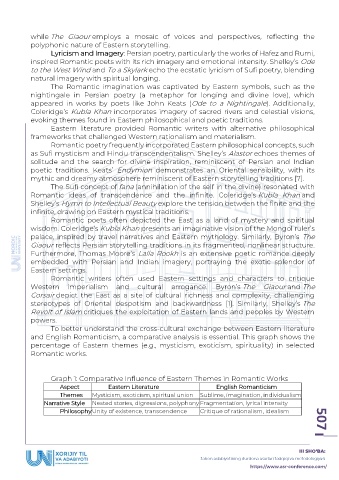Page 509 - Konferensiya to'plami - 1 (ASR)
P. 509
while The Giaour employs a mosaic of voices and perspectives, reflecting the
polyphonic nature of Eastern storytelling.
Lyricism and Imagery: Persian poetry, particularly the works of Hafez and Rumi,
inspired Romantic poets with its rich imagery and emotional intensity. Shelley’s Ode
to the West Wind and To a Skylark echo the ecstatic lyricism of Sufi poetry, blending
natural imagery with spiritual longing.
The Romantic imagination was captivated by Eastern symbols, such as the
nightingale in Persian poetry (a metaphor for longing and divine love), which
appeared in works by poets like John Keats (Ode to a Nightingale). Additionally,
Coleridge’s Kubla Khan incorporates imagery of sacred rivers and celestial visions,
evoking themes found in Eastern philosophical and poetic traditions.
Eastern literature provided Romantic writers with alternative philosophical
frameworks that challenged Western rationalism and materialism.
Romantic poetry frequently incorporated Eastern philosophical concepts, such
as Sufi mysticism and Hindu transcendentalism. Shelley’s Alastor echoes themes of
solitude and the search for divine inspiration, reminiscent of Persian and Indian
poetic traditions. Keats’ Endymion demonstrates an Oriental sensibility, with its
mythic and dreamy atmosphere reminiscent of Eastern storytelling traditions [7].
The Sufi concept of fana (annihilation of the self in the divine) resonated with
Romantic ideas of transcendence and the infinite. Coleridge’s Kubla Khan and
Shelley’s Hymn to Intellectual Beauty explore the tension between the finite and the
infinite, drawing on Eastern mystical traditions.
Romantic poets often depicted the East as a land of mystery and spiritual
wisdom. Coleridge’s Kubla Khan presents an imaginative vision of the Mongol ruler’s
palace, inspired by travel narratives and Eastern mythology. Similarly, Byron’s The
Giaour reflects Persian storytelling traditions in its fragmented, nonlinear structure.
Furthermore, Thomas Moore’s Lalla Rookh is an extensive poetic romance deeply
embedded with Persian and Indian imagery, portraying the exotic splendor of
Eastern settings.
Romantic writers often used Eastern settings and characters to critique
Western imperialism and cultural arrogance. Byron’s The Giaour and The
Corsair depict the East as a site of cultural richness and complexity, challenging
stereotypes of Oriental despotism and backwardness [1]. Similarly, Shelley’s The
Revolt of Islam critiques the exploitation of Eastern lands and peoples by Western
powers.
To better understand the cross-cultural exchange between Eastern literature
and English Romanticism, a comparative analysis is essential. This graph shows the
percentage of Eastern themes (e.g., mysticism, exoticism, spirituality) in selected
Romantic works.
Graph 1: Comparative Influence of Eastern Themes in Romantic Works
Aspect Eastern Literature English Romanticism
Themes Mysticism, exoticism, spiritual union Sublime, imagination, individualism
Narrative Style Nested stories, digressions, polyphony Fragmentation, lyrical intensity
Philosophy Unity of existence, transcendence Critique of rationalism, idealism
507
III SHO‘BA:
Jahon adabiyotining durdona asarlari tadqiqi va metodologiyasi
https://www.asr-conference.com/

